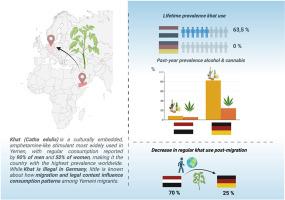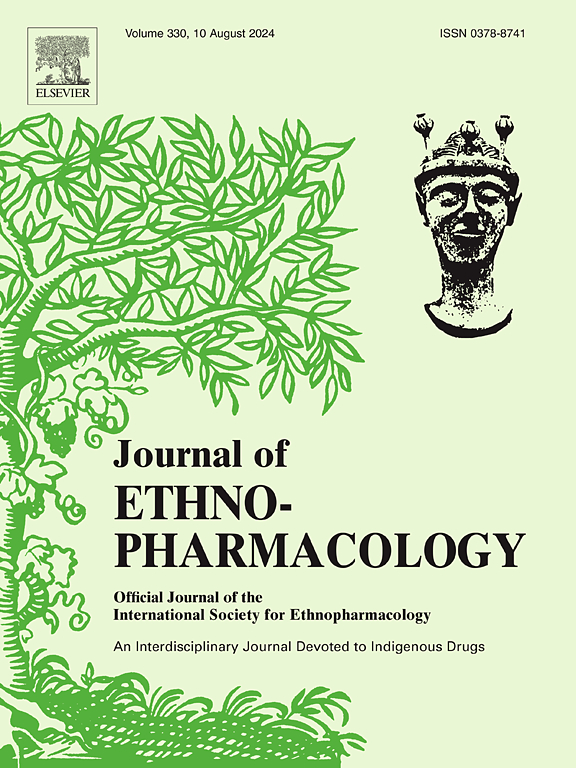EuroKhat: A pilot study on Khat consumption among Yemeni migrants in Germany
IF 5.4
2区 医学
Q1 CHEMISTRY, MEDICINAL
引用次数: 0
Abstract
Ethnopharmacological relevance
Khat (Catha edulis), an amphetamine-like stimulant, is deeply rooted in the sociocultural traditions of the Arabian Peninsula and the Horn of Africa, with regular consumption reported by 90 % of men and 50 % of women in Yemen. Beyond its sociocultural role, khat use has been associated with adverse mental health outcomes, including anxiety, insomnia, stress, dysphoric mood, and, in cases of frequent high-dose use, psychosis. Migration to non-khat-producing countries in Europe may alter consumption patterns, yet data on its use among Yemeni migrants in Germany remains limited.
Material and methods
This study examined khat consumption patterns among Yemeni migrants in Germany compared to a non-Yemeni control group. A total of 278 participants (159 Yemeni migrants and 119 non-Yemeni residents) completed an anonymous online survey assessing sociodemographic factors, substance use, and mental health, using validated scales (DASS-21, UCLA Loneliness Scale, SCL-90).
Results
Reported Khat use was prevalent among Yemeni migrants (63.5 % lifetime use), however retrospective assessments indicate a significant decline in frequent use post-migration. The fraction of participants reporting rare or no use increased from 30 % in Yemen to 75 % in Germany, while occasional use remained stable. No significant associations were found between khat use and psychological distress (depression, anxiety, stress, or psychotic symptoms). However, a significant negative correlation between khat use and loneliness (ρ = −0.29, p = 0.003). None of the control group had ever used khat, yet they reported significantly higher alcohol and cannabis consumption.
Conclusion
While khat remains a key cultural practice in Yemeni migrants, none of the non-Yemeni residents ever consumed Khat. In contrast, non-Yemeni reported higher alcohol and cannabis use, underscoring sociocultural influences on substance use. As a pilot study with limited sample size and descriptive analyses, the findings are preliminary and should be interpreted with caution. Future research should explore the role of cultural adaptation and social integration in shaping substance use behaviors among migrant populations.

欧洲阿拉伯茶:在德国的也门移民阿拉伯茶消费的试点研究。
民族药理学相关性:阿拉伯茶(Catha edulis)是一种类似安非他明的兴奋剂,深深植根于阿拉伯半岛和非洲之角的社会文化传统中,据报告,也门90%的男性和50%的女性经常食用阿拉伯茶。除了其社会文化作用外,阿拉伯茶的使用还与不利的心理健康结果有关,包括焦虑、失眠、压力、烦躁情绪,在频繁高剂量使用的情况下,还与精神病有关。移民到欧洲非阿拉伯茶生产国可能会改变消费模式,但在德国的也门移民使用阿拉伯茶的数据仍然有限。材料和方法:本研究调查了在德国的也门移民与非也门对照组的阿拉伯茶消费模式。共有278名参与者(159名也门移民和119名非也门居民)完成了一项匿名在线调查,使用有效的量表(DASS-21、UCLA孤独量表、SCL-90)评估社会人口因素、物质使用和心理健康。结果:报告的阿拉伯茶使用在也门移民中很普遍(63.5%的终生使用),然而回顾性评估表明,移民后频繁使用阿拉伯茶的人数显著下降。报告很少使用或不使用的参与者比例从也门的30%上升到德国的75%,而偶尔使用的比例保持稳定。使用阿拉伯茶与心理困扰(抑郁、焦虑、压力或精神病症状)之间未发现显著关联。然而,阿拉伯茶的使用与孤独感呈显著负相关(ρ = -0.29, p = 0.003)。对照组中没有人使用过阿拉伯茶,但他们报告的酒精和大麻消费量明显更高。结论:虽然阿拉伯茶在也门移民中仍然是一种重要的文化习俗,但没有一个非也门居民消费过阿拉伯茶。相比之下,非也门人报告的酒精和大麻使用率较高,这突显了社会文化对药物使用的影响。作为一项样本量有限和描述性分析的试点研究,研究结果是初步的,应谨慎解释。未来的研究应探讨文化适应和社会融合在塑造流动人口物质使用行为中的作用。
本文章由计算机程序翻译,如有差异,请以英文原文为准。
求助全文
约1分钟内获得全文
求助全文
来源期刊

Journal of ethnopharmacology
医学-全科医学与补充医学
CiteScore
10.30
自引率
5.60%
发文量
967
审稿时长
77 days
期刊介绍:
The Journal of Ethnopharmacology is dedicated to the exchange of information and understandings about people''s use of plants, fungi, animals, microorganisms and minerals and their biological and pharmacological effects based on the principles established through international conventions. Early people confronted with illness and disease, discovered a wealth of useful therapeutic agents in the plant and animal kingdoms. The empirical knowledge of these medicinal substances and their toxic potential was passed on by oral tradition and sometimes recorded in herbals and other texts on materia medica. Many valuable drugs of today (e.g., atropine, ephedrine, tubocurarine, digoxin, reserpine) came into use through the study of indigenous remedies. Chemists continue to use plant-derived drugs (e.g., morphine, taxol, physostigmine, quinidine, emetine) as prototypes in their attempts to develop more effective and less toxic medicinals.
 求助内容:
求助内容: 应助结果提醒方式:
应助结果提醒方式:


